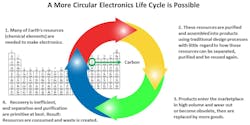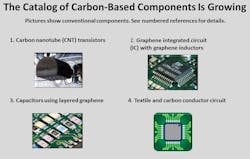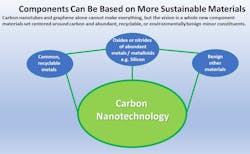Carbon-Based Components: A Solution for Sustainability?
Members can download this article in PDF format.
What you'll learn:
- Current directives and standards targeting end-of-life recycling.
- How carbon nanotubes are being used to create new components.
- The latest advances in graphene-based developments.
This story of future electronic component materials begins in the distant past. Consider the Stone Age that lasted for millions of years, when mankind was limited to tools made of, well, stone. Just a few thousand years ago, the Bronze Age brought in metalworking using copper and tin. What followed in the relatively more modern Iron Age was basically iron alloyed with carbon to make steel. These phases of early technology have very short bills of material.
Fast forward to today, where microelectronics is based on complex thin films that are typically, but not exclusively, on silicon substrates. These devices may incorporate dozens of chemical elements and many more chemical compounds. One such list that covers just semiconductor materials, compound materials, and alloys made of between one and four chemical elements numbers over 100. The necessary peripheral components like passives and interconnect add even more.
Packaging of final products is also interesting in its own right, but that will be saved for another time. It does, however, offer a return path for common metals that will be needed only in small amounts for carbon-based devices and could be recovered in the same recycling processes, as discussed next.
Advances in End-of-Life Recycling Tech
The electronics end-of-life recycling technology is becoming established for some metals at least, and to a lesser extent with larger plastic parts used as device housings. Thanks to requirements like the EU’s WEEE Directive on Waste Electrical and Electronic Equipment and similar regulations in U.S. states, infrastructure is developing for recovery and recycling of electronics.
The issue is that except for a few common metals, notably copper and precious metals like gold, palladium, and silver, almost nothing else from components is generally recovered to go back to its next life. In the EU, standard “EN 50625-Part 5: Specification for the final treatment of WEEE fractions - Copper and precious metals” requires at least 90% recovery by mass of copper, gold, silver, and palladium. These kinds of requirements help ensure that at least these important metals will have a recovery stream in some regions.
From a U.S. perspective, the ISRI Specifications Circular published by the Institute of Scrap Recycling Industries Inc. defines several categories of electronic goods for recycling, which is an important step forward in electronics recycling. As of today, though, it has no coverage of the small amounts of all the other substances and complex materials that make electronics functional. The problem of so many other metals and materials of all kinds without a return path remains, and it’s the subject of this current discussion.
Sustainability is a big topic these days, and the electronics industry is quickly becoming a significant enabler of the low-carbon economy. But from a materials perspective, while devices and products continue to get physically smaller and include more software content, the number of specialty materials continues to grow.
Here we speculate how electronic component technology might continue to evolve while realizing some rollback of the growing number of Earth’s resources that are required. Figure 1 shows how a less-resource-intensive and more-closed-loop product lifecycle could be accomplished by using nanotechnology based on specific kinds of the very common element carbon.
Emerging Trends: Graphene, Carbon Nanotubes, and Beyond
A first glimpse of the carbon device future was the 1996 Nobel Prize in Physics, awarded for discovery of domed-shape materials made of nothing but carbon. Commonly known as fullerenes, or Buckyballs, they had also been fabricated into tube shapes called carbon nanotubes (CNTs).
While their chemical and mechanical properties were of great interest, CNTs were found to also be outstanding electrical conductors. A few years later, the 2010 Physics Nobel Prize was awarded for a flat, two-dimensional (2D) carbon structure called graphene that was only one carbon atom thick. The search for practical applications wasn’t far away.
Transistors were an important first step for carbon electronics. CNT transistors have rapidly evolved into field-effect types, Schottky barrier transistors, and even integrated circuits. One such development is a logic circuit fabricated from single-walled CNTs made without even requiring a second material doping process.
In early versions, as reported in year 2012, to achieve n-and p-type materials, two different metal contacts made with scandium (Sc) and palladium (Pd) were used. The use of scandium is somewhat outside of the carbon-based vision offered here, while palladium is already recognized as a standard metal to be recovered from end-of-life electronics. Further research and incentives to use only common and recyclable metals could improve this.
Jumping to graphene, a recent Electronic Design article highlights these developments. Ancillary materials reported in those devices included silicon and aluminum in the form of carbides or oxides.
The next step involving integration of multiple carbon transistors into ICs didn’t take long. Integrated circuits with inductors were developed some time ago with three layers of graphene on a silicon-carbide wafer, using the familiar silicon dioxide for a spacer. While the metal contacts used are the familiar precious metals gold and palladium, an organic-layer-based PMMA [poly(methyl methacrylate)] was employed along with silicon compound hydrogen silsesquioxane, H-SiOx.
Just this year, yet another approach to 2D ICs was reported, using graphene and oxidized graphene, as well as some PMMA along with gold and chromium electrodes. There are many such reports as researchers push the envelope of carbon electronics capability. This represents a trend toward carbon-based components using commonly available metals and minor amounts of other materials, which are of no particular concern for availability or regulated due to toxicity.
Other Graphene Developments: Stacked and Twisted
We already cited an example of a graphene-based IC that included inductors. We can easily predict that creating capacitors similar to the standard construction of stacked layers of conductors and insulators may be coming, too. In fact, stacked graphene has already been investigated for supercapacitors. Making resistors—and some readers may recall carbon composition types—also seems to be a natural for a natural conductor given a few modifications. Figure 2 shows examples of carbon-based components being developed.
One of the more interesting features of graphene is its ability to behave as either a superconductor or an insulator, based on the positioning of different graphene sheets called twisted graphene. This results from a so-called “magic angle” of how the graphene sheets interact.
Though that may seem simple, the angle is critical, and this work is some years away from practical applications requiring volume manufacturing and reasonable cost. But the incentive is there and groups like the Graphene Flagship, which is based in the EU and funded by the European Commission’s Horizon research program, are bringing together researchers from academia and industry to commercialize graphene in applications like memory devices and sensors, to name a few.
Not to be overlooked is the excellent conductivity of CNTs. Given their light weight compared to metals like copper, using them for wires and cable applications has shown promise, especially for applications like aerospace and satellites where performance and weight are critical factors.
Reducing the Reliance on Material Complexity
In this article, we have speculated on an electronics future built largely with carbon-based components, to realize active components like transistors, logic devices, and even passives like chip capacitors, inductors, and resistors. A graphic of this vision is shown in Figure 3.
Thanks to advances in materials like carbon nanotubes and graphene, we may someday be able to take a quantum leap toward improving the material circularity of electronic hardware, while enabling growth in new functionality. Like the system-on-chip approach, and developments in conductive textiles and printed electronics, these advances may reduce reliance on so much material complexity and create more closed-loop material recovery and resource reuse.
While we have no carbon component catalog to promote here quite yet, stay tuned.
Read more articles in the TechXchange: Sustainable Electronics.
References (from Figure 2)
1. M. Kolahdouz et. al., “Carbon-Related Materials: Graphene and Carbon Nanotubes in Semiconductor Applications and Design,” Micromachines (Basel). 2022 Aug; 13(8): 12572.
2. Y. Lin et. al., “Wafer-Scale Graphene Integrated Circuit,” Science Vol. 332, No. 6035 (2011).
3. B. Oi et. al., “Design of layered-stacking graphene assemblies as advanced electrodes for supercapacitors,” Particuology, Volume 60, January 2022, pp. 1-13.
4. G.B. Tseghai et. al., “Integration of Conductive Materials with Textile Structures, an Overview,” Sensors 2020, 20(23), 6910.
More may be found in the video, “The future of carbon electronics.”
About the Author
Roger L. Franz
Environmental Sustainability Advocate and Contributing Author
Roger Franz has served as Principal, Engineering IT at TE Connectivity, Research Engineer at UL Environment, and Group Leader and Design for Environment Manager at Motorola. In addition to product environmental compliance and standards, his passions include new product development, quality, and technology research. His papers have appeared in several industry journals. He has had over a dozen article published in Electronic Design. He holds a BA and MS in chemistry from Grinnell College and Northwestern University, respectively.




